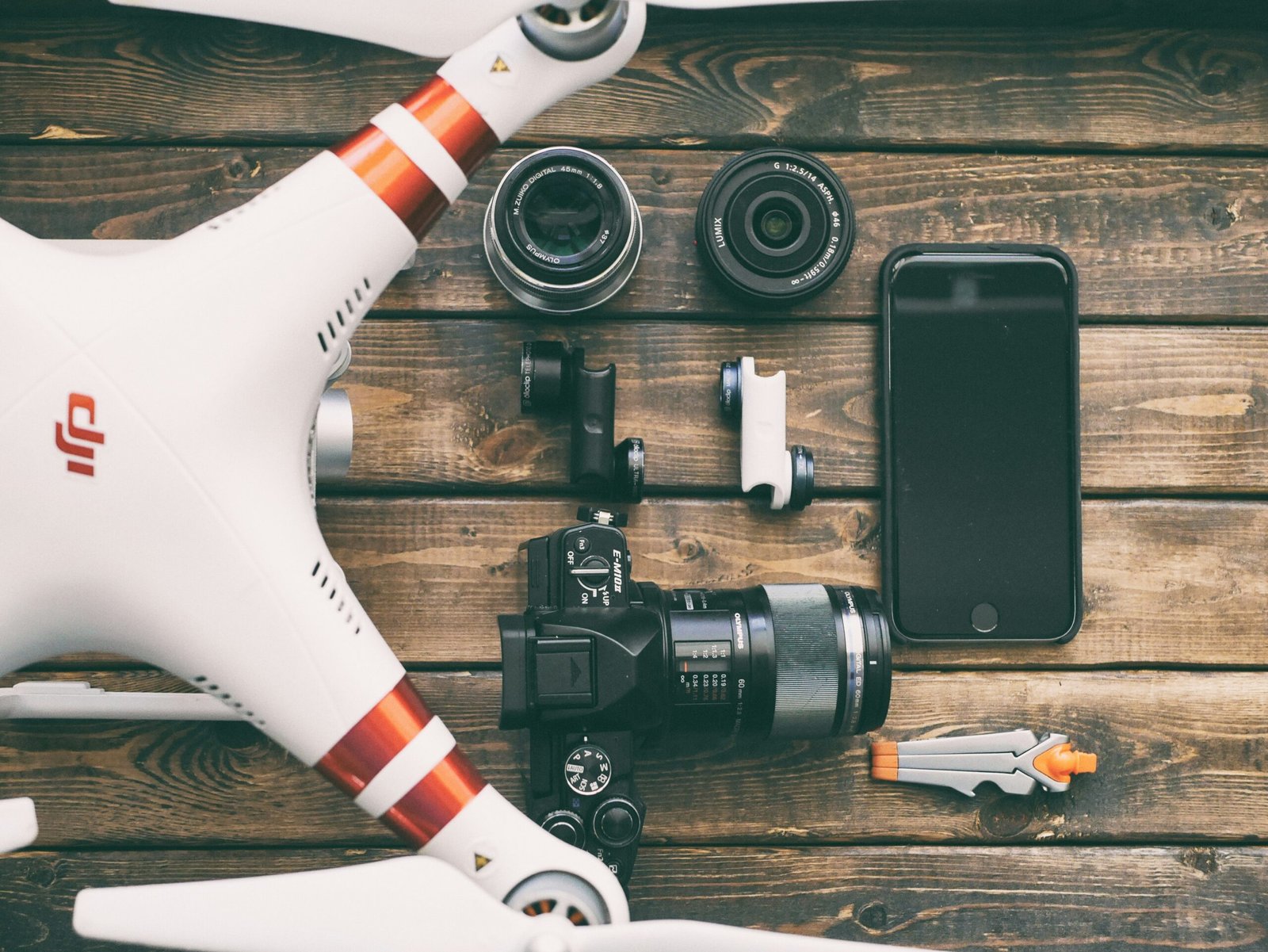In recent years, drones have transformed from niche gadgets to essential tools across various industries. Whether you’re a hobbyist, a professional filmmaker, or a business owner exploring cutting-edge technologies, drones offer immense potential. This article delves into what drones are, their types, applications, benefits, challenges, and the future of drone technology.
Everything You Need to Know About Drones: A Comprehensive Guide

In recent years, drones have transformed from niche gadgets to essential tools across various industries. Whether you’re a hobbyist, a professional filmmaker, or a business owner exploring cutting-edge technologies, drones offer immense potential. This article delves into what drones are, their types, applications, benefits, challenges, and the future of drone technology.
What is a Drone?
A drone, technically referred to as an Unmanned Aerial Vehicle (UAV), is an aircraft that operates without a human pilot onboard. These devices are typically controlled remotely or programmed to follow specific flight paths using onboard sensors and GPS. Drones vary in size, functionality, and design, making them suitable for a diverse range of applications.
Types of Drones
Drones can be categorized based on their design, purpose, and mode of operation. Below are the primary types:
- Fixed-Wing Drones
- Designed like airplanes with wings.
- Known for long flight durations and high speeds.
- Commonly used in large-scale mapping, surveying, and military operations.
- Multirotor Drones
- Include quadcopters, hexacopters, and octocopters.
- Highly maneuverable and easy to control.
- Popular for photography, videography, and recreational use.
- Single-Rotor Drones
- Resemble helicopters with one main rotor and a tail rotor.
- Can carry heavy payloads and hover for extended periods.
- Frequently used in industrial applications.
- Hybrid VTOL Drones
- Combine fixed-wing capabilities with vertical take-off and landing (VTOL) features.
- Ideal for applications requiring flexibility and long-range capabilities.
Applications of Drones
The versatility of drones has unlocked countless possibilities across industries. Here are some of the most prominent applications:
- Aerial Photography and Videography
Drones equipped with high-resolution cameras have revolutionized filmmaking, journalism, and social media content creation. They allow stunning perspectives and dynamic shots that were once costly or impossible to achieve. - Agriculture
- Crop monitoring and analysis using multispectral cameras.
- Precision spraying of pesticides and fertilizers.
- Livestock tracking in large fields.
- Delivery Services
Companies like Amazon and UPS are experimenting with drone delivery systems to provide faster and more efficient last-mile delivery solutions. - Construction and Real Estate
- Site inspections and progress monitoring.
- Creating 3D maps and models of construction sites.
- Showcasing properties through aerial footage.
- Public Safety and Disaster Response
- Search-and-rescue missions in remote areas.
- Assessing damage after natural disasters.
- Assisting firefighting operations with thermal imaging.
- Environmental Monitoring
- Tracking wildlife and their habitats.
- Monitoring deforestation and illegal activities like poaching.
- Studying environmental changes over time.
- Military and Defense
- Surveillance and reconnaissance missions.
- Target identification and precision strikes.
- Border patrol and maritime security.
Benefits of Drones
Drones have emerged as invaluable tools due to the numerous advantages they offer:
- Cost Efficiency
Drones eliminate the need for expensive helicopters, planes, and large crews, significantly reducing operational costs. - Improved Accessibility
They can reach inaccessible or hazardous areas, making them indispensable for search-and-rescue missions and environmental studies. - Time-Saving
Drones can perform tasks like mapping large areas or inspecting infrastructure faster than traditional methods. - Enhanced Data Collection
Equipped with advanced sensors, drones provide high-quality, real-time data for better decision-making. - Creative Freedom
For artists and filmmakers, drones offer unparalleled creativity by capturing unique angles and perspectives.
Challenges and Limitations of Drones
Despite their advantages, drones face several challenges:
- Regulatory Issues
- Strict aviation laws govern drone usage to ensure safety and privacy.
- Operators must often obtain licenses and follow no-fly zone restrictions.
- Battery Life
Most consumer drones have limited flight times, typically ranging from 20 to 30 minutes, which can hinder extended operations. - Security Concerns
Drones can be hacked or misused for malicious purposes, raising concerns about privacy and public safety. - Weather Sensitivity
Strong winds, rain, and extreme temperatures can impact drone performance and safety. - Skill Requirements
Operating drones, especially for professional purposes, requires training and expertise.
The Future of Drones
The drone industry is evolving rapidly, driven by technological advancements and increasing demand. Here are some trends shaping the future of drones:
- Autonomous Drones
AI-powered drones capable of independent navigation and decision-making are becoming more common, reducing the need for human intervention. - Swarm Technology
Swarm drones, which operate in coordinated groups, hold promise for applications like disaster relief, agriculture, and military operations. - Longer Flight Times
Innovations in battery technology and alternative energy sources like solar power aim to extend flight durations significantly. - Advanced Sensors and Cameras
Enhanced imaging capabilities, such as 8K cameras and hyperspectral sensors, will enable even more precise data collection. - Integration with IoT
Drones are increasingly being integrated with the Internet of Things (IoT), enabling seamless communication with other devices and systems. - Urban Air Mobility (UAM)
The concept of passenger drones and flying taxis is gaining traction, with companies like EHang and Uber exploring this futuristic mode of transportation.
How to Choose the Right Drone
If you’re considering buying a drone, here are some factors to consider:
- Purpose
Determine whether you need a drone for recreational, professional, or industrial use. - Budget
Drones range from affordable models for beginners to high-end devices costing thousands of dollars. - Features
Look for features like GPS, obstacle avoidance, camera resolution, and flight modes based on your requirements. - Regulations
Research the drone laws in your area to ensure compliance. - Brand and Support
Choose a reputable brand that offers good customer support, spare parts, and firmware updates.
Conclusion
Drones have become a transformative force, reshaping industries and enabling new possibilities. As technology continues to evolve, the role of drones will only expand, making them an integral part of our lives. Whether you’re exploring drones for personal or professional use, understanding their capabilities, challenges, and future potential is the key to harnessing their full power.
Invest in the right drone today and be a part of this exciting technological revolution!

What is a Drone?
A drone, technically referred to as an Unmanned Aerial Vehicle (UAV), is an aircraft that operates without a human pilot onboard. These devices are typically controlled remotely or programmed to follow specific flight paths using onboard sensors and GPS. Drones vary in size, functionality, and design, making them suitable for a diverse range of applications.
Types of Drones
Drones can be categorized based on their design, purpose, and mode of operation. Below are the primary types:
- Fixed-Wing Drones
- Designed like airplanes with wings.
- Known for long flight durations and high speeds.
- Commonly used in large-scale mapping, surveying, and military operations.
- Multirotor Drones
- Include quadcopters, hexacopters, and octocopters.
- Highly maneuverable and easy to control.
- Popular for photography, videography, and recreational use.
- Single-Rotor Drones
- Resemble helicopters with one main rotor and a tail rotor.
- Can carry heavy payloads and hover for extended periods.
- Frequently used in industrial applications.
- Hybrid VTOL Drones
- Combine fixed-wing capabilities with vertical take-off and landing (VTOL) features.
- Ideal for applications requiring flexibility and long-range capabilities.
Applications of Drones
The versatility of drones has unlocked countless possibilities across industries. Here are some of the most prominent applications:
- Aerial Photography and Videography
Drones equipped with high-resolution cameras have revolutionized filmmaking, journalism, and social media content creation. They allow stunning perspectives and dynamic shots that were once costly or impossible to achieve. - Agriculture
- Crop monitoring and analysis using multispectral cameras.
- Precision spraying of pesticides and fertilizers.
- Livestock tracking in large fields.
- Delivery Services
Companies like Amazon and UPS are experimenting with drone delivery systems to provide faster and more efficient last-mile delivery solutions. - Construction and Real Estate
- Site inspections and progress monitoring.
- Creating 3D maps and models of construction sites.
- Showcasing properties through aerial footage.
- Public Safety and Disaster Response
- Search-and-rescue missions in remote areas.
- Assessing damage after natural disasters.
- Assisting firefighting operations with thermal imaging.
- Environmental Monitoring
- Tracking wildlife and their habitats.
- Monitoring deforestation and illegal activities like poaching.
- Studying environmental changes over time.
- Military and Defense
- Surveillance and reconnaissance missions.
- Target identification and precision strikes.
- Border patrol and maritime security.
Benefits of Drones
Drones have emerged as invaluable tools due to the numerous advantages they offer:
- Cost Efficiency
Drones eliminate the need for expensive helicopters, planes, and large crews, significantly reducing operational costs. - Improved Accessibility
They can reach inaccessible or hazardous areas, making them indispensable for search-and-rescue missions and environmental studies. - Time-Saving
Drones can perform tasks like mapping large areas or inspecting infrastructure faster than traditional methods. - Enhanced Data Collection
Equipped with advanced sensors, drones provide high-quality, real-time data for better decision-making. - Creative Freedom
For artists and filmmakers, drones offer unparalleled creativity by capturing unique angles and perspectives.
Challenges and Limitations of Drones
Despite their advantages, drones face several challenges:
- Regulatory Issues
- Strict aviation laws govern drone usage to ensure safety and privacy.
- Operators must often obtain licenses and follow no-fly zone restrictions.
- Battery Life
Most consumer drones have limited flight times, typically ranging from 20 to 30 minutes, which can hinder extended operations. - Security Concerns
Drones can be hacked or misused for malicious purposes, raising concerns about privacy and public safety. - Weather Sensitivity
Strong winds, rain, and extreme temperatures can impact drone performance and safety. - Skill Requirements
Operating drones, especially for professional purposes, requires training and expertise.
The Future of Drones
The drone industry is evolving rapidly, driven by technological advancements and increasing demand. Here are some trends shaping the future of drones:
- Autonomous Drones
AI-powered drones capable of independent navigation and decision-making are becoming more common, reducing the need for human intervention. - Swarm Technology
Swarm drones, which operate in coordinated groups, hold promise for applications like disaster relief, agriculture, and military operations. - Longer Flight Times
Innovations in battery technology and alternative energy sources like solar power aim to extend flight durations significantly. - Advanced Sensors and Cameras
Enhanced imaging capabilities, such as 8K cameras and hyperspectral sensors, will enable even more precise data collection. - Integration with IoT
Drones are increasingly being integrated with the Internet of Things (IoT), enabling seamless communication with other devices and systems. - Urban Air Mobility (UAM)
The concept of passenger drones and flying taxis is gaining traction, with companies like EHang and Uber exploring this futuristic mode of transportation.
How to Choose the Right Drone
If you’re considering buying a drone, here are some factors to consider:
- Purpose
Determine whether you need a drone for recreational, professional, or industrial use. - Budget
Drones range from affordable models for beginners to high-end devices costing thousands of dollars. - Features
Look for features like GPS, obstacle avoidance, camera resolution, and flight modes based on your requirements. - Regulations
Research the drone laws in your area to ensure compliance. - Brand and Support
Choose a reputable brand that offers good customer support, spare parts, and firmware updates.
Conclusion
Drones have become a transformative force, reshaping industries and enabling new possibilities. As technology continues to evolve, the role of drones will only expand, making them an integral part of our lives. Whether you’re exploring drones for personal or professional use, understanding their capabilities, challenges, and future potential is the key to harnessing their full power.
Invest in the right drone today and be a part of this exciting technological revolution!
Internal Link :- ragdi








